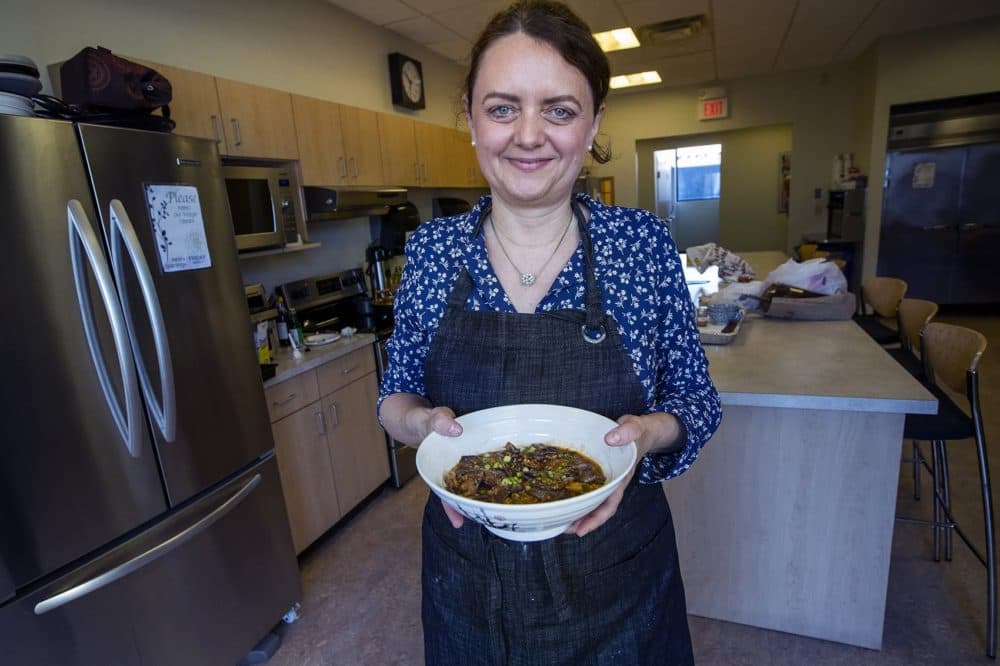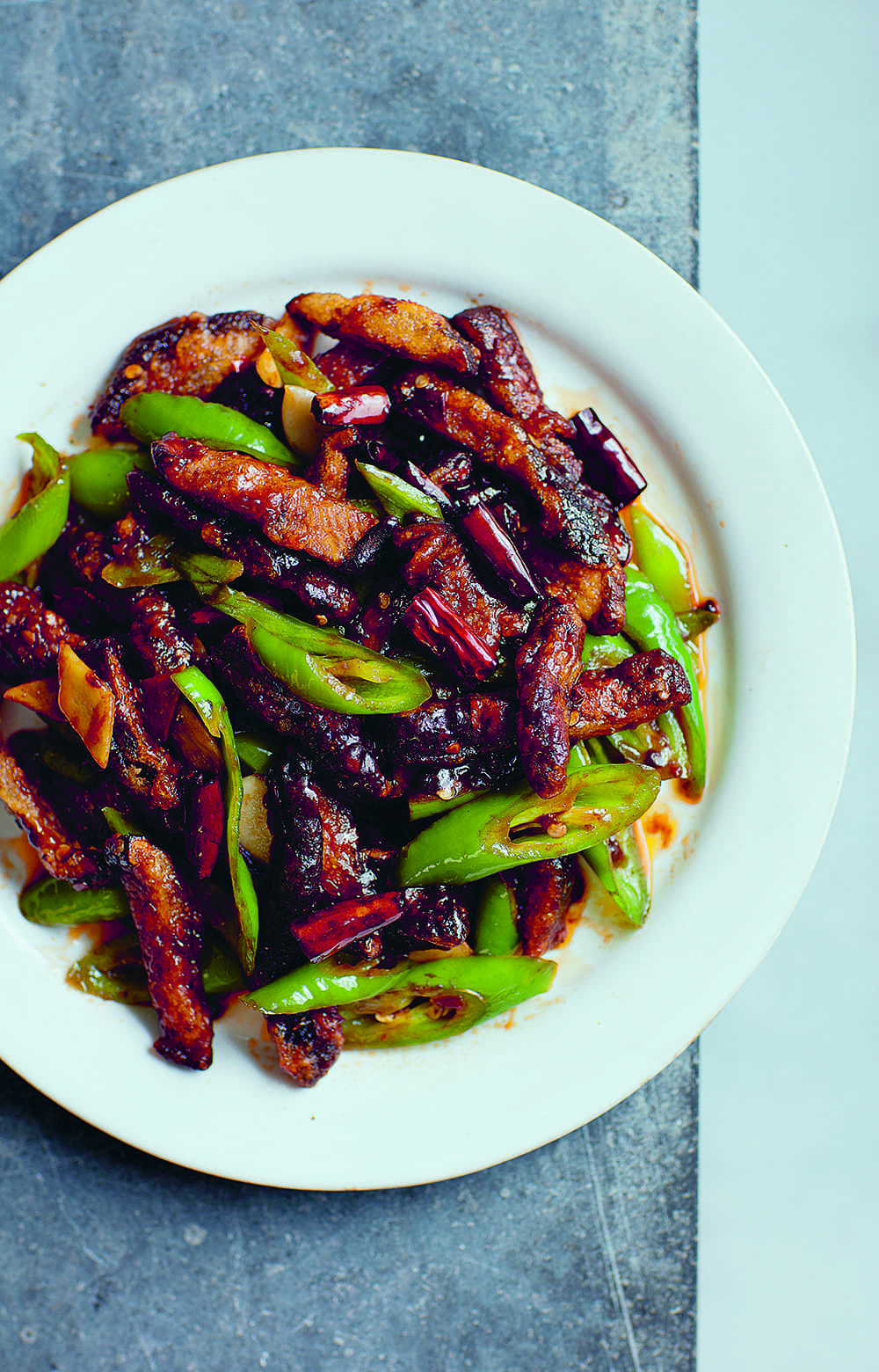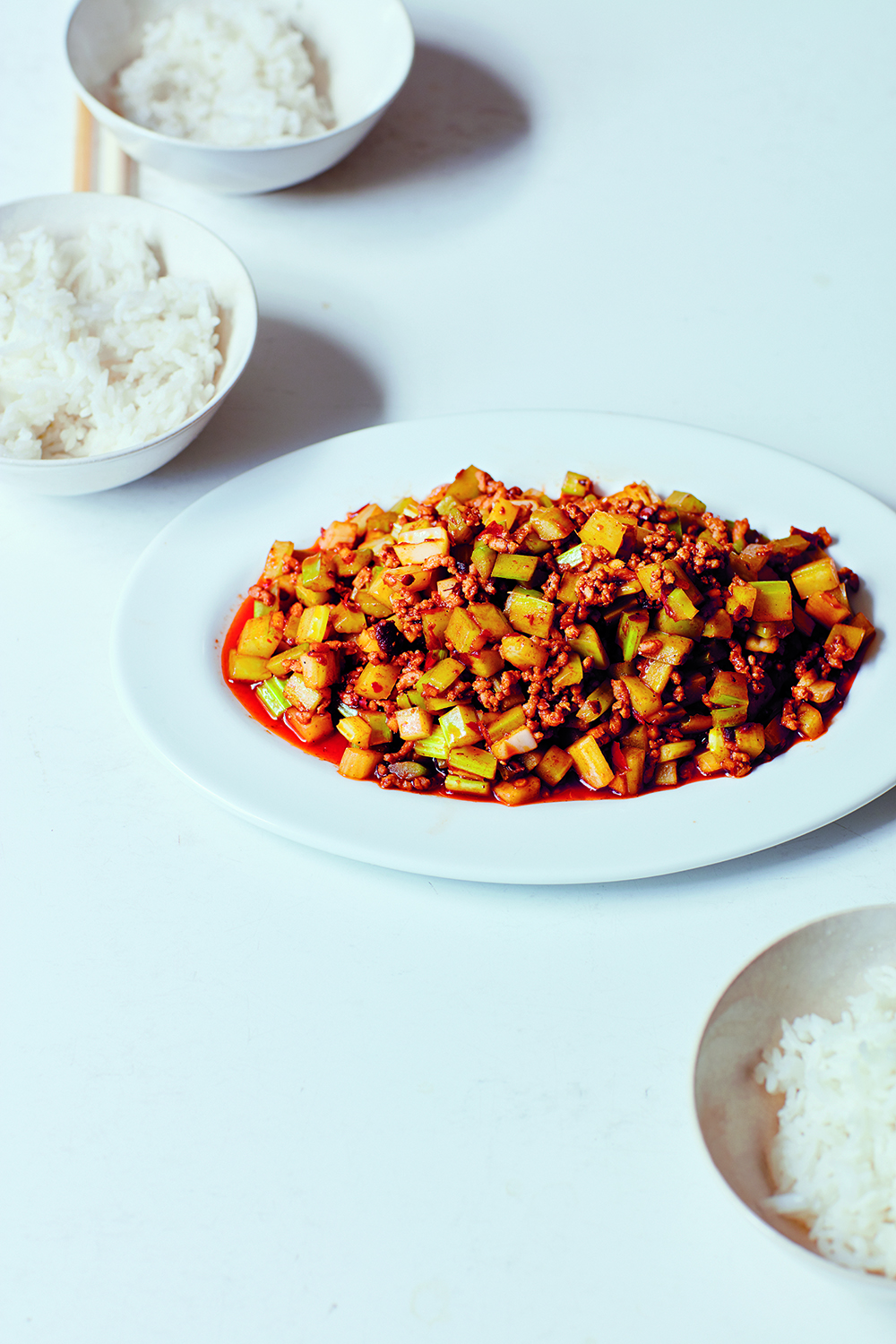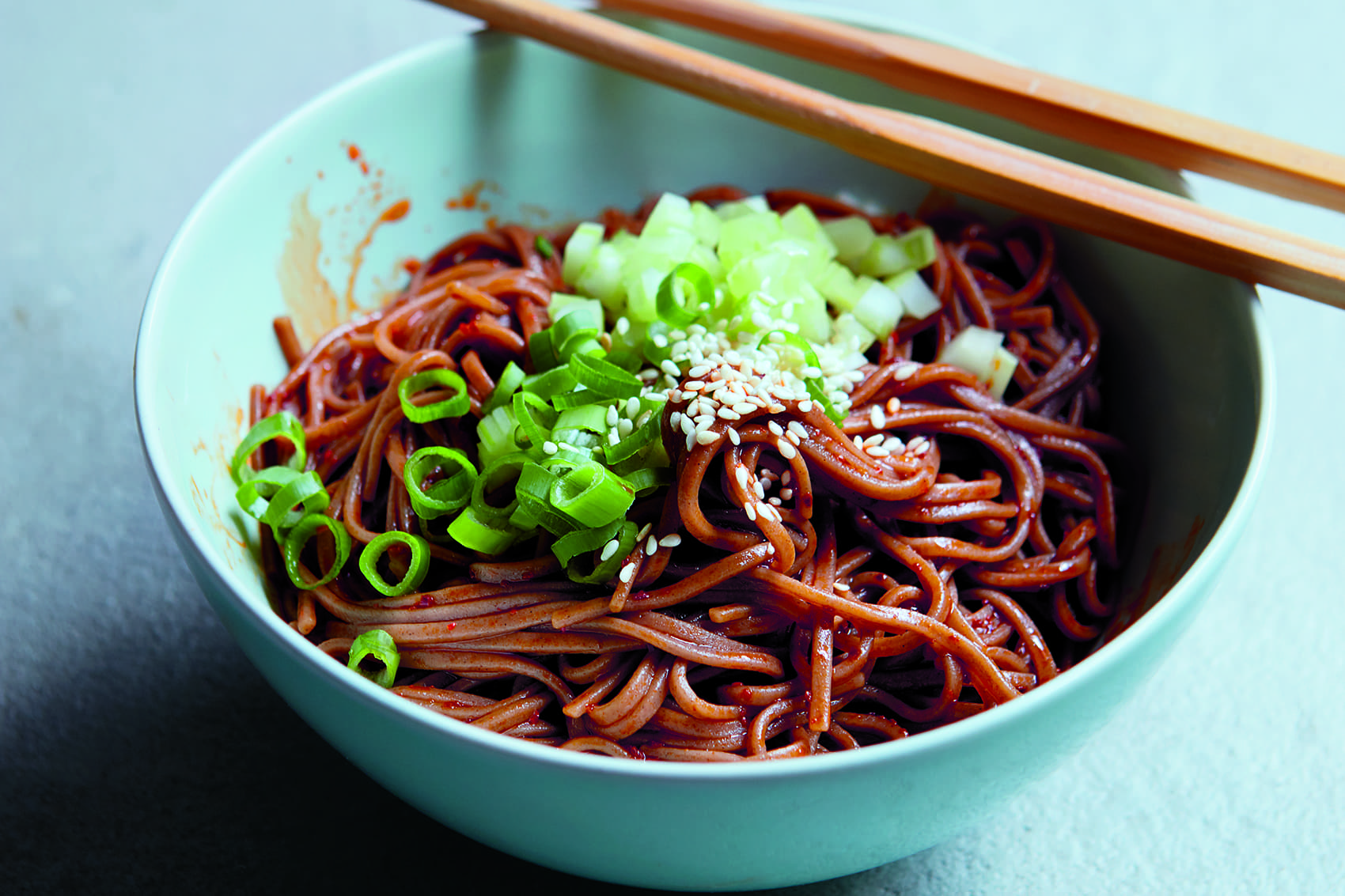Advertisement
A Culinary Journey Through 'The Food Of Sichuan'

This hour originally aired Oct. 24, 2019.
The secret sauce and spices of Sichuanese cooking. Get ready for a master class. Recipes included.
Guest
Fuchsia Dunlop, cook and food writer specializing in Chinese cuisine. Award-winning author of the new book "The Food of Sichuan." She's also the author of "Land of Plenty," among other books. First Westerner to train as a chef at the Sichuan Institute of Higher Cuisine in Chengdu. (@fuchsiadunlop)
Recipes
Dry-fried “Eels” (Shiitake Mushrooms)
ganbian shanyu 干煸鳝鱼

This delicious example of Buddhist trompe l’oeil cooking is based on a memorable version I enjoyed in the restaurant at the Temple of Divine Light, near Chengdu. The “eels,” made from dried shiitake mushrooms, look strikingly similar to the real paddy eels used in the classic Sichuanese recipe. The original dish did not include garlic, which strict Buddhists avoid as one of the pungent vegetables thought to inflame carnal passions, but I’ve added it here for extra deliciousness. Dried mushrooms are particularly important in Chinese vegetarian cooking because of their enticing savory flavors and satisfyingly meaty textures. I like to use long, thin-skinned Turkish peppers, for their more delicate texture and milder taste.
Ingredients
- 10–12 dried shiitake mushrooms (9 oz/250g after soaking)
- 2/3 cup (75g) potato starch
- 8 dried chiles
- 61/4 oz (175g) long green Turkish peppers
- Cooking oil, for deep-frying
- 1 tsp whole Sichuan pepper
- 1½ tbsp Sichuan chile bean paste
- 3 garlic cloves, peeled and sliced
- An equivalent amount of ginger, peeled and sliced
- 1 tsp sesame oil
For the sauce
- ¾ tsp potato starch
- ½ tsp superfine sugar
- 1 tsp light soy sauce
- ¼ tsp dark soy sauce
Instructions
- Place the dried mushrooms in a saucepan, cover with hot water from the kettle and leave to soften for at least 30 minutes. Bring to a boil, season lightly with salt and simmer the mushrooms for 20 minutes, then drain. When they are cool enough to handle, squeeze out as much water as possible, then cut into strips about 1/2 inch (1.5cm) wide. Place in a bowl with the potato starch and mix until evenly coated. Snip the chiles in half or into 3/4-inch (2cm) sections and shake out the seeds as much as possible. Cut the green peppers into bite-sized pieces. In a small bowl, combine the sauce ingredients with 4 tbsp cold water and mix well.
- Heat the deep-frying oil in a wok over high heat to about 375°F (190°C) (hot enough to sizzle vigorously around a test piece of mushroom). Working in two or three batches, carefully slip the mushrooms into the hot oil, adding them individually so they don’t stick together. Fry for a minute or so until crisp and a little golden, then remove with a slotted spoon and drain well.
- Carefully pour off all but 3 tbsp oil from the wok, and return to high heat. Add the chiles and Sichuan pepper and stir-fry briefly until the chiles are aromatic, but not burned. Immediately move the wok away from the heat and add the chile bean paste, stirring as it sizzles, until the oil has reddened. Add the garlic, ginger and green pepper and return the wok to the stove, stir-frying until everything is piping hot and smells delicious. Swiftly stir in the mushrooms, then give the sauce a stir and pour it into the center of the wok. Mix quickly to allow the sauce to coat the mushrooms as it thickens. Stir in the sesame oil and serve.
Advertisement
Stir-fried Celery with Ground Pork
lanrou xiqin 烂肉西芹

This simple, scrumptious stir-fry is typical of Sichuanese “home-style” cooking. The recipe, which is similar to the celery and beef dish from my book Every Grain of Rice but with an extra kick of chile oil and Sichuan pepper, is based on one from Zhang Guobin and Li Qi, respectively chef and owner of one of my favorite backstreet restaurants in Chengdu. It’s easy to make and, with plain white rice, can serve as a meal for two in itself. In Sichuan they use Chinese celery, which is thinner and more aromatic than the kind typically eaten in the West, but I find the dish more delicious when made with regular Western celery, which is juicier.
Ingredients
- 10 oz (300g) celery (about 5–6 sticks)
- 3 tbsp cooking oil
- 31/2 oz (100g) ground pork
- 1½ tbsp Sichuan chile bean paste
- 1½ tbsp finely chopped ginger
- 1 tsp light soy sauce
- 1 tsp Chinkiang vinegar
- ¼ tsp ground roasted
- Sichuan pepper, or to taste
- 1 tbsp chile oil
Instructions
- Remove any strings from the celery sticks, cut them lengthwise into 1/2-inch (1cm) strips, and then finely chop the strips.
- Heat the cooking oil in a seasoned wok over high heat. Add the pork and stir-fry until pale, breaking the meat into tiny morsels as it cooks. Add the chile bean paste and continue to stir-fry until the oil is red and fragrant, then tip in the ginger and stir-fry until it also smells wonderful. Add the celery and continue to stir-fry until it is piping hot, adding the soy sauce as you go. Add the vinegar and give it a lick of heat.
- Finally, stir in the Sichuan pepper and chile oil, and serve.
Cold Buckwheat Noodles
liang qiaomian 凉荞面

Both sweet and bitter (or tartary) varieties of buckwheat are grown in Aba Prefecture and other dry, mountainous parts of Sichuan. Bitter buckwheat, which is thought to help regulate blood sugar and is therefore recommended for diabetics, has become fashionable in recent years in the form of a herbal tea that has a satisfying, roasty taste. Buckwheat is also used to make noodles, which are a particular specialty of Chongzhou, just west of Chengdu. Buckwheat flour made from the ground seeds is worked with water and a little lime solution into a soft dough, which is squeezed through holes in a wooden press so the noodles fall directly into a wokful of boiling water. The boiled noodles, quickly rinsed in cold water, can be eaten hot with a spoonful of red-braised beef stew, or cold with sour and spicy seasonings, as in the following recipe, which is inspired by the one served at a specialty buckwheat noodle restaurant in Chengdu, Granny Wang’s.
Dried buckwheat noodles can be fragile and prone to disintegration, while those made from a mixture of buckwheat and wheat tend to hold their shape better: use whichever you prefer. Do regard this recipe as a template for experimentation: try adding crushed garlic, sesame oil, deep-fried soy beans, roasted or fried peanuts, or chopped cilantro, for example. This dish makes a quick, fabulous vegetarian snack—the recipe makes 2 servings.
Ingredients
- 7 oz (200g) dried buckwheat orbuckwheat-and-wheat noodles
- 2 small handfuls of finely chopped
- celery (1–2 celery sticks)
- 4 tbsp thinly sliced scallion greens
- ½ tsp toasted sesame seeds
For the seasonings
- ¼ tsp salt
- 4 tsp light soy sauce
- 2 tbsp Chinkiang vinegar
- ½ tsp superfine sugar
- 2 tbsp chile oil, plus 1 tbsp sediment
- ¼–½ tsp ground roasted Sichuanpepper (optional)
Instructions
- Boil the noodles to your liking. Divide all the seasonings between two bowls. When the noodles are ready, tip them into a colander and quickly rinse under cold water, then drain well. Divide the noodles between the bowls and mix well.
- Scatter over the remaining ingredients and serve.
Variations
In Sichuan, people also love to serve buckwheat noodles with soupy red-braised beef (see p. 168). To do this as they do at Granny Wang’s, season the noodles with a little light soy sauce, vinegar and ground roasted Sichuan pepper, to taste, then top with a good ladleful of red-braised beef. Finish with chile oil and plenty of chopped garlic and sliced scallion greens. Mix well before eating.
Excerpted from FOOD OF SICHUAN: A New and Updated Edition of the Classic Land of Plenty. Copyright © 2019 by copyright holder. Used with permission of the publisher, W.W. Norton & Company, Inc. All rights reserved.
From The Reading List
Gourmet Traveler: "Fuchsia Dunlop is in love with Sichuan cuisine" — "Sichuan cuisine has become the new champion of Chinese food abroad. While once the lighter flavours of Cantonese cooking held sway in global Chinatowns, this spicy upstart has conquered hearts and palates not only in great cities like Melbourne, London and New York, but all over the world. Classic Sichuan dishes like ma po tofu and dan dan noodles are no longer toned down for Cantonese or Western palates, but served up in all their fiery, lip-tingling glory. The rapidity of this Sichuanese takeover has been astonishing.
"When I applied for a scholarship to study in China in the mid-1990s, I was strongly influenced by Sichuan's gastronomic reputation, but knew almost nothing about the region's cuisine. At that time, there were no genuine Sichuan restaurants in London, and while the names of a few classic dishes popped up from time to time on Chinese restaurant menus, they were pale imitations of the authentic versions. In 1993, however, a trip to the Sichuan capital Chengdu had opened my eyes to the scintillating flavours of the local food, and I knew I wanted to learn more about it. On that visit, a couple of Sichuanese friends had taken me out to eat, and I'd been thrilled and delighted by my first tastes of dishes such as fish-fragrant eggplant, fish braised in chilli bean sauce and fire-exploded kidney flowers.
"Of course, that was just the beginning. I took up my scholarship at Sichuan University in 1994, but was quickly seduced away from my studies by my fascination with the local cuisine. I spent days in the kitchens of local restaurants, took a few private classes at the famous local cooking school, the Sichuan Higher Institute of Cuisine, and ended up becoming the first foreigner to enrol there as a regular student."
New York Times: "As Chinese ‘Crepe’ Catches On Abroad, a Fight to Preserve Its Soul" — "When is a pancake not a pancake?
"The unassuming jianbing, an eggy street-food snack from China that resembles a French crepe, is increasingly trendy abroad — a symbol of Beijing’s growing soft power. It even inspired the creation of a superhero character in a hit Chinese comedy, 'Pancake Man.'
"But in the Chinese city of Tianjin, a local trade association sees the snack’s soaring popularity — and variety — as a threat. Over the weekend, it imposed rules that attempt to standardize the jianbing, apparently as a way of saving the soul of northern China’s quintessential street food.
"The rules have prompted head-scratching among Chinese eaters, and even some metaphysical speculation about what makes a jianbing in the first place.
"The rules say that Tianjin’s jianbing vendors should hew to a fixed recipe and a precise pancake-diameter range of 15 to 17.7 inches, according to photographs of the rules that were posted online by Chinese state media outlets. The rules also say that a jianbing should be served in packaging that lists its expiration date and the name, address and phone number of its creator."
This program aired on December 26, 2019.

